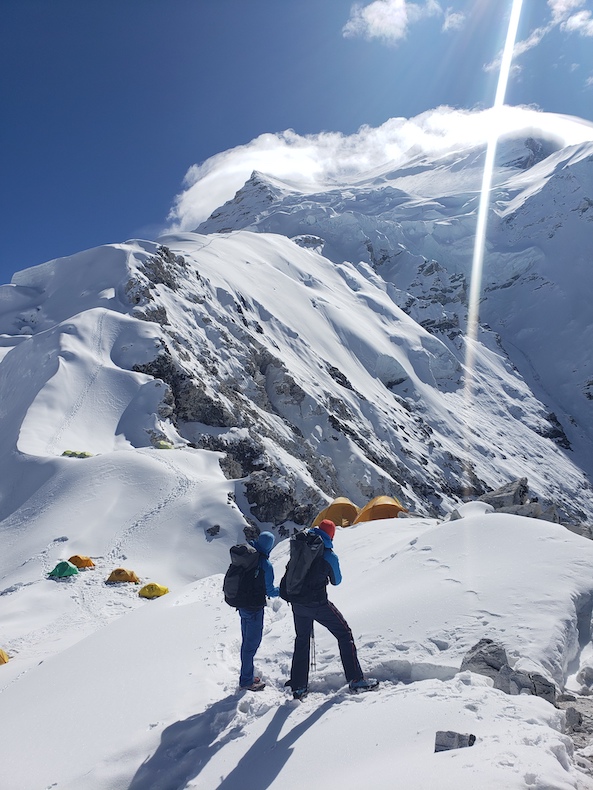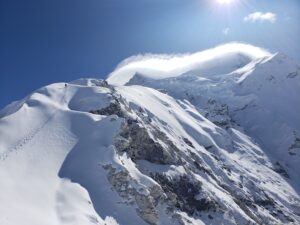Cho Oyu vs. Manaslu


For many people trying to prepare for Everest, climbing an 8,000m peak the fall before heading to Everest is the best way to get the experience necessary to find success. It is widely thought that the two “easiest” 8,000m peaks are Cho Oyu in Tibet, and Manaslu in Nepal. Here at Alpenglow, we only climb Cho Oyu. And we wanted to highlight some of the reasons why we choose to climb Cho, and why we do not guide on Manaslu.
When it comes to selecting a fall 8,000m peak, there are many factors to consider. For Alpenglow, we focus on choosing mountains and routes that will set our teams up for success while minimizing objective hazards. Here are some of the questions that we ask ourselves to make sure we’re giving the best mountain experience possible:
1). Can the objective hazard on the route be mitigated by good guiding decisions?
Cho Oyu ✅
Manaslu ❌
Cho Oyu has very little objective hazard that cannot be mitigated within reason by certified, professional mountain guides. The camps are protected and the terrain is low angle with minimal overhead hazard. This means that our guides can focus on helping the team manage their temperatures, energy, and all the other difficulties of climbing at 8,000m without needing to worry about risk that is completely out of their control. Our guides can use their years of experience and training to make decisions that help our teams succeed, knowing that the inherent risks that come with high-altitude mountaineering are being handled with intention rather than hope.
As mountain guides, our job is to mitigate risk and facilitate a powerful mountain experience. When there is a mountain or a route that takes away our ability to mitigate objective hazards, we can no longer do our jobs.
We do not guide on Manaslu because of the objective hazard that is presented on the route. In 2012, there was an avalanche that hit Camp 3 which lead to the deaths of 11 people. A similar avalanche ripped the slopes on Manaslu this last fall, killing one and injuring 12. The avalanche paths are known, threaten the normal route for large parts of the climb, and have proven to slide year after year. The hazard on Manaslu is unpredictable, making it impossible for guides to make decisions that mitigate risk for their team.

2). Does the route present an acceptable level of risk for our Sherpa/high altitude workers?
Cho Oyu ✅
Manaslu ❌
For every trip to a high camp that a team member makes, a Sherpa may make that same climb 4-5x. That means 4-5x the risk. We would not be able to climb these mountains without our Sherpa teams, and we’re committed to making sure that our Sherpa’s are comfortable with the risk that they take to help support us.
On Cho Oyu, our Sherpa are still taking more risk than our team members due to the increased time they spend climbing on the mountain, but the terrain and objective hazard on the mountain is manageable with their years of experience. The same cannot be said about the terrain on Manalsu, and the risk to our Sherpa team would be too great for us to accept if we ran open enrollment teams on the mountain.
 3). Does the mountain allow us to provide the best, high-quality logistics that set our teams up for success?
3). Does the mountain allow us to provide the best, high-quality logistics that set our teams up for success?
Cho Oyu ✅
Manaslu ❌
On Cho Oyu, thanks to the Rapid Ascent Approach, we’re able to drive straight to Base Camp at 15,750’ (4,800m). This allows us to make sure our team arrives to the mountain strong and healthy, have fresh produce delivered weekly, and cut the time spent on the mountain down significantly. A traditional 8,000m peak expedition runs 6 weeks; our Cho Oyu expedition is only 4 weeks. This means that team members are reducing their risk by reducing their time spent on the mountain, and reducing their time spent away from family and work. Cho Oyu lends itself perfectly to our industry-leading Rapid Ascent Approach.
When teams spend a week trekking into base camp on mountains like Manaslu, the risk of getting sick and jeopardizing the expedition before even reaching the mountain increase significantly. By driving straight to base camp, we take the risk of getting sick on the way to the mountain out of the equation.
We firmly believe that comfort in base camp leads to successful summits. Our base camp and advanced base camp on Cho Oyu are built with the intention to maximize comfort and support during the expedition. We have professional chefs that prepare healthy, clean, fresh food for our team members. We have personal tents, group dining tents, and hang-out tents that help make the mountain feel more like home. No detail is left overlooked.
Stoked to see for yourself?
We will be returning to Cho Oyu for the first time in three years, and as the longest-standing American outfitter in the Tibetan Himalayas, we can hardly wait. If you’re keen on climbing your first 8,000m peak this fall, choose the mountain that has the most manageable objective hazard with the American operator that has the most experience.
